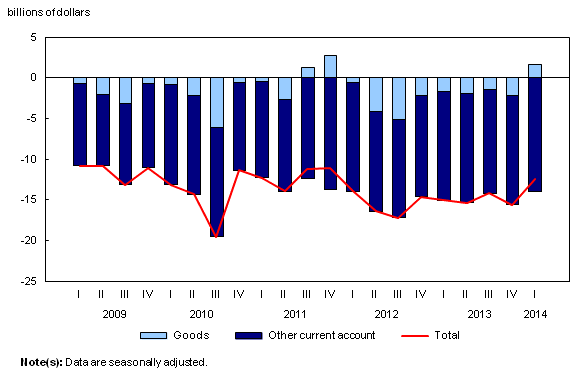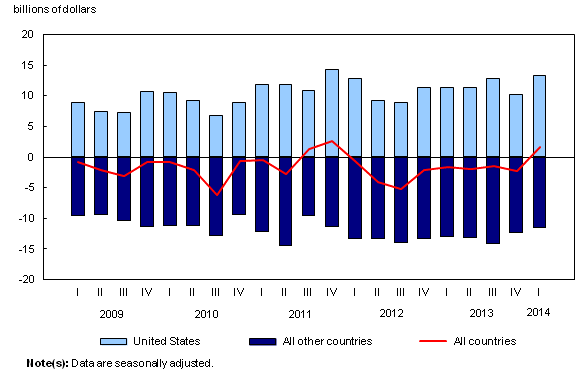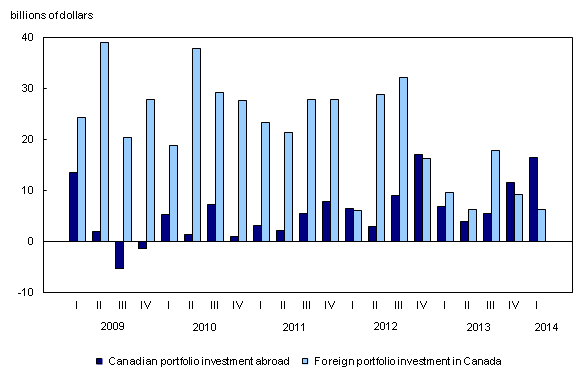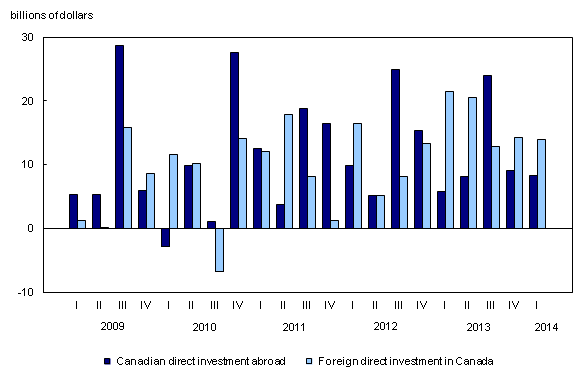Canada's balance of international payments, first quarter 2014
Archived Content
Information identified as archived is provided for reference, research or recordkeeping purposes. It is not subject to the Government of Canada Web Standards and has not been altered or updated since it was archived. Please "contact us" to request a format other than those available.
Released: 2014-05-29
Canada's current account deficit (on a seasonally adjusted basis) narrowed by $3.3 billion to $12.4 billion in the first quarter. This increase was led by an improved trade in goods balance, which recorded a first surplus in more than two years.
In the financial account (unadjusted for seasonal variation), increased foreign currency deposits placed by non-residents in Canada was, for a second straight quarter, the largest contributor to the inflow of funds into the Canadian economy.
Current account
The trade balance on goods returns to a surplus position
The balance on international trade in goods posted a $1.6 billion surplus in the first quarter, following a $2.2 billion deficit in the previous quarter. This was the first overall surplus since the end of 2011. On a geographical basis, the trade surplus with the United States widened by $3.1 billion to $13.2 billion on the strength of exports of energy products. The deficit with all other countries declined for a second consecutive quarter.
Total exports of goods increased by $6.5 billion to $127.7 billion in the first quarter, marking its highest level since the third quarter of 2008. Exports of energy products were up by $6.0 billion. Crude petroleum increased by $2.6 billion, reflecting higher prices and volumes. Natural gas was up by $3.0 billion, led by a spike in prices. Automotive products were down by $0.6 billion as a result of lower volumes of automobiles exported. This reduction was the main contributor to the overall decrease in volumes of goods exported in the quarter.
Overall imports of goods increased by $2.7 billion to $126.2 billion, despite lower volumes in most trade categories. Imports of energy products advanced by $1.0 billion, mainly on higher volumes of refined petroleum products. The other energy products also increased but from higher prices. Metal and non-metallic minerals products increased by $0.9 billion, led by stronger volumes of precious metals. Industrial machinery equipment and parts was up $0.9 billion. These increases were moderated by lower volumes of automotive products, with parts accounting for the bulk of the $0.7 billion reduction for that category.
Deficit on trade in services expands
The deficit on international transactions in services increased by $0.4 billion to $6.3 billion in the first quarter. This was reflected in all three major categories of services.
The surplus on commercial services was down by $0.2 billion as imports increased by more than exports. Financial services advanced for both imports and exports. The deficit on international travel edged up by $0.1 billion, mostly on higher expenses of Canadians travelling overseas. The transportation deficit also edged up by $0.1 billion, reflecting higher payments on water transport of goods.
Deficit on investment income edges down
The deficit on cross border investment income edged down to $6.6 billion in the first quarter. Increases in receipts exceeded payments in the quarter.
On the receipt side, earnings of Canadian investors on their holdings of foreign securities were up by $0.3 billion on higher dividends and interest. Profits of Canadian direct investors on their operations abroad were largely unchanged in the quarter. Earnings on banking assets accounted for the remainder of the increase for receipts.
On the payments side, profits earned by foreign direct investors on their operations in Canada increased by $0.5 billion. In addition, there was higher interest paid to non-residents on their holdings of Canadian bonds, mainly foreign currency-denominated corporate bonds.
Financial account
Canadian investment in foreign securities exceeds foreign investment in Canadian securities
Transactions in the portfolio investment category of the financial account led to a net outflow of funds of $10.4 billion in the first quarter, the highest since the fourth quarter of 2007.
On the asset side, Canadian investors acquired $16.5 billion of foreign securities with nearly two-thirds in equities. This was the highest such investment in five years and was mainly focused on non-US foreign shares. Canadian investors also increased their holdings of foreign bonds by $6.0 billion, an eighth straight quarter of investment.
On the other side of the ledger, foreign investment in Canadian securities slowed to $6.1 billion, the lowest in two years. Non-residents continued to reallocate funds from government securities to corporate securities in the quarter.
Foreign investors mainly acquired Canadian equities, adding $7.6 billion to their portfolios as the stock market gained 5.2% to reach the highest level since June 2008. This marked a fourth straight quarter of investment in Canadian stocks for a total of $36.3 billion acquired during this period.
In the Canadian debt market, foreign investors withdrew large amounts of funds from the money market for a second straight quarter. Holdings were down by $5.2 billion, mainly in the form of retirements of federal Treasury bills. On the other hand, foreign acquisitions of Canadian bonds were $3.7 billion, led by foreign-currency denominated corporate bonds but moderated by a continued reduction in holdings of federal government bonds.
Canadian long-term interest rates decreased by 27 basis points in the first quarter and the Canadian dollar continued to depreciate against the US dollar, down by 3.6 US cents between December 2013 and March 2014.
Inward direct investment outstrips outward direct investment
The direct investment account posted a net inflow of funds to the Canadian economy for a second straight quarter. Foreign direct investment in Canada was $13.9 billion, down slightly from the level of activity of the previous quarter. Non-US foreign direct investors contributed to the bulk of the inflows, which were equally split between merger and acquisition activity and other transactions.
Canadian direct investment abroad slowed to $8.2 billion, the lowest in three quarters. Merger and acquisition transactions accounted for half of the investment. Most of the investment was directed to the finance and insurance sector.
Other investments lead the inflow of funds from abroad
Transactions in the other investment category of the financial account generated a net inflow of funds of $19.9 billion in the first quarter. For a second straight quarter, this activity mainly reflected an increase in foreign currency deposits held by non-residents in Canada. These inflows were moderated by a $4.7 billion increase in Canada's official international reserves.
Note to readers
The balance of international payments covers all economic transactions between Canadian residents and non-residents in three accounts: the current account, the capital account and the financial account.
The current account covers transactions in goods, services, compensation of employees, investment income and secondary income (current transfers).
The current account data in this release are seasonally adjusted. For more information on seasonal adjustment, see "Seasonal adjustment and identifying economic trends."
The capital account covers capital transfers and transactions in non-produced non-financial assets.
The financial account comprises transactions in financial assets and liabilities.
In principle, a net lending (+) / net borrowing (-) derived from the sum of the current and capital accounts corresponds to a net lending (+) / net borrowing (-) derived from the financial account. In practice, as data are compiled from multiple sources, this is rarely the case and gives rise to measurement error. The discrepancy (net errors and omissions) is the unobserved net inflow or outflow.
For more information about the balance of payments, consult the "Frequently asked questions" section in the System of macroeconomic accounts module of our website. The module also presents the most recent balance of payments statistics.
The balance of international payments data for the second quarter will be released on August 28.
Contact information
For more information, contact us (toll-free 1-800-263-1136; 514-283-8300; infostats@statcan.gc.ca).
To enquire about the concepts, methods or data quality of this release, contact Denis Caron (613-951-1861; denis.caron@statcan.gc.ca), International Accounts and Trade Division.
- Date modified:





